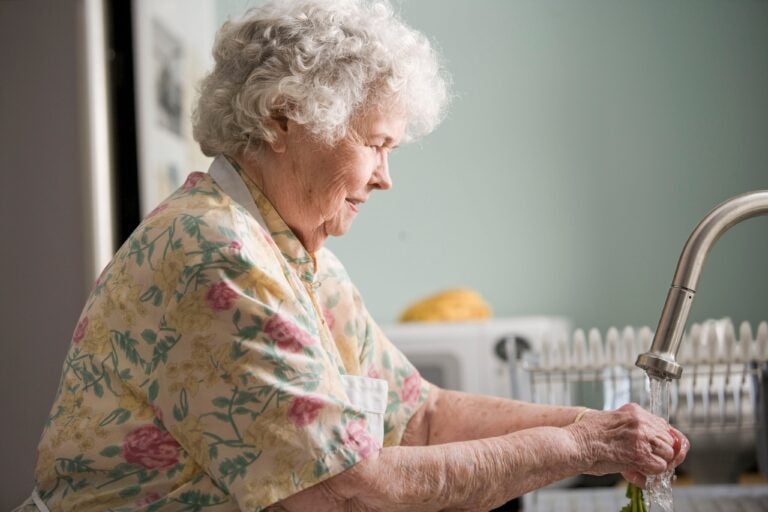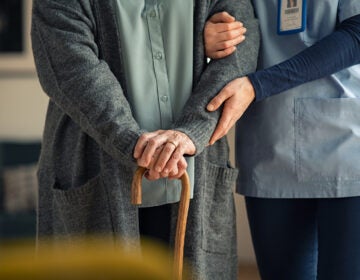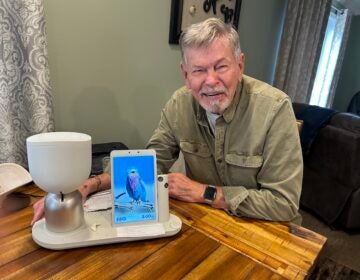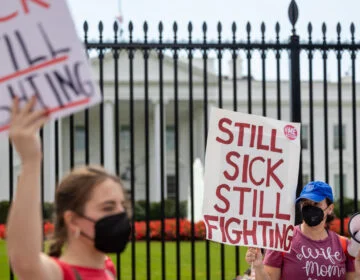Battling older adults’ greater social isolation during COVID-19
Before the coronavirus struck, loneliness was an “epidemic” among the elderly in the U.S. The pandemic revealed it was just part of the problem.

(@cdc/Unsplash)
Ask us about COVID-19: What questions do you have about the coronavirus and vaccines?
In February 2020, the National Academy of Science, Engineering, and Medicine released a report investigating what the former U.S. surgeon general called an “epidemic” among America’s aging population: loneliness.
One year later, local gerontologists and community health experts say they’ve learned a lot from fighting two health crises at once.
“Social isolation and loneliness is something a lot of people are concerned about for older adults, for good reasons,” said Dr. Joel Streim, a psychiatry professor at the University of Pennsylvania and a former consultant in geriatric psychiatry at the Philadelphia VA Medical Center. “I think that that was the first pandemic: loneliness and social isolation. And then COVID brought the second pandemic, if you will.”
Prior to the pandemic, much of the research on geriatric mental health highlighted two main risk factors for social isolation and mental health decline among older adults: ageism and mental illness. But now, Streim said, new research conducted since the dawn of the coronavirus is illustrating how other factors are contributing significantly, too.
“I think what we’ve learned as the result of COVID is that it’s also not just ageism, not just mental illness. It’s poverty. It’s racism. It’s other things that are isolating. The pandemic of social isolation and loneliness was caused by the rapid advances in technology and communications, and also globalization — those people left behind in the world economy as a result of all those major changes and upheavals,” Streim said. “The pandemic adds another layer of isolation and potential for loneliness.”
COVID-19 has also changed the way we manage those risk factors. For Wanda Mitchell, director of community engagement at Philadelphia Corporation for Aging, that meant rethinking how to implement vital programs for older Philadelphians.
“Most of our services are in the community serving those older adults in person. And so we knew right away the Philadelphia Corporation for Aging would have to readjust,” Mitchell said.
Before the pandemic, the organization funded 28 senior wellness centers across the city that provided free meals for those over 60 during weekdays, as well as social programs to keep seniors informed and engaged. Mitchell and her colleagues had to reimagine safe ways to keep older adults physically nourished and mentally stimulated.
“Having connections to other people, having that network of informal support is a huge social determinant of health,” Mitchell said. “So when we talk about older adults no longer being able to congregate in a facility in the senior center, that definitely weighed heavily. There’s less interaction with loved ones and members of the community, meaning that they lose social stimulation.”
The organization quickly pivoted to virtual social programming, as well as conducting wellness calls. It converted its dine-in meal services to grab-and-go and delivery to provide over 500,000 meals last year.
“It does not replace in-person, but it definitely plays a significant and key role. Because people are able to see their friends on the virtual calls, those that they would participate in a senior center with. And even with the grab-and-go meals, they’re at least able to see those the staff that are distributing the meals to them,” Mitchel said.
Dr. Brooke Salzman, a physician at the Center for Healthy Aging at Thomas Jefferson University Hospital, emphasized the important role places such as senior centers play in helping to maintain a schedule for older adults, a key component in fighting anxiety, depression, and overall cognitive decline. But keeping a schedule virtually isn’t always easy for seniors.
“We’ve certainly spent more time with our patients to try to help them to use the technology, not always successfully. So there are some people that this just will not work for,” said Salzman, and health insurers aren’t making it any easier.
“The fact that health insurances are only covering for telemedicine video visits, not telephone visits, is a huge barrier for older adults because if that person can’t do a video visit, I don’t get that same time to spend with them on the phone,” Salzman said. Thanks to a grant, the center was able to donate more than 65 iPads to older adults with chronic illnesses to help fill the gap.
Still, Salzman said, she’s noticed some of her patients feeling forgotten during lockdowns.
“I’ve definitely heard people say that they feel invisible and that they feel kind of left behind. That there are young people who are out and about and kind of disregarding risk because they can, and not really considering how to make things safe for them,” Salzman said.
Still, Streim said, research is highlighting just how resilient older adults have been during the ongoing crisis and the importance of wisdom accumulated over a lifetime.
“Learning to tolerate solitary time, and actually value it, and enjoy being alone is something that older adults in many cases can do fairly well, even better than they did when they were younger,” Streim said. “And so there’s a lot of older adults who are retired from health care jobs who are going back and volunteering. They are doing what we call successful aging. They have a sense of purpose, and they are remaining engaged.”
“That’s just an example of what some older adults are doing in response to the COVID crisis. And that’s resiliency.”

Get daily updates from WHYY News!
WHYY is your source for fact-based, in-depth journalism and information. As a nonprofit organization, we rely on financial support from readers like you. Please give today.




![CoronavirusPandemic_1024x512[1]](https://whyy.org/wp-content/uploads/2020/03/CoronavirusPandemic_1024x5121-300x150.jpg)



